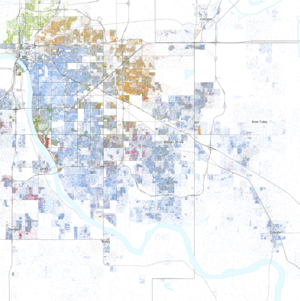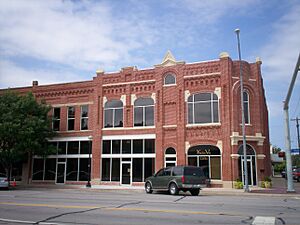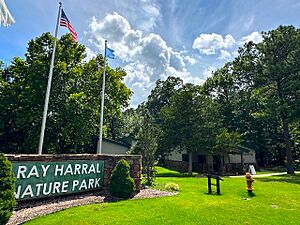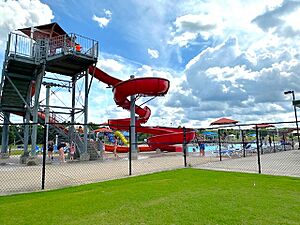Broken Arrow, Oklahoma facts for kids
Quick facts for kids
Broken Arrow, Oklahoma
|
|
|---|---|
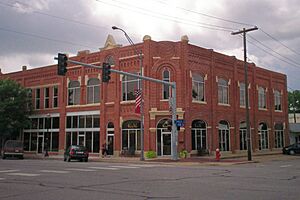
Downtown Broken Arrow (2007)
|
|
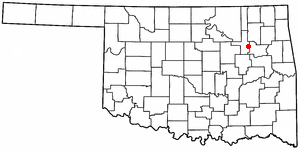
Location within the state of Oklahoma
|
|
| Country | United States |
| State | Oklahoma |
| Counties | Tulsa, Wagoner |
| Founded | 1902 |
| Incorporated | 1903 |
| Government | |
| • Type | Council-Manager |
| Area | |
| • City | 63.54 sq mi (164.58 km2) |
| • Land | 62.96 sq mi (163.07 km2) |
| • Water | 0.58 sq mi (1.51 km2) |
| Elevation | 755 ft (230 m) |
| Population
(2020)
|
|
| • City | 113,540 |
| • Rank | US: 279th |
| • Density | 1,803.34/sq mi (696.28/km2) |
| • Metro | 411,401 (US: 54th) |
| Time zone | UTC−6 (CST) |
| • Summer (DST) | UTC−5 (CDT) |
| ZIP codes |
74011-74014
|
| Area code(s) | 539/918 |
| FIPS code | 40-09050 |
| GNIS feature ID | 1090512 |
Broken Arrow is a city in Oklahoma, a state in the United States. It is located in Tulsa and Wagoner counties. Broken Arrow is the largest suburb of Tulsa. In 2020, the city had 113,540 residents. This makes it the fourth largest city in Oklahoma. Broken Arrow is part of the larger Tulsa Metropolitan Area. This area has over one million people.
The city's name comes from a Creek Native American community. This community was forced to move from Alabama to Oklahoma in the 1830s. This journey is known as the Trail of Tears. The Missouri–Kansas–Texas Railroad sold land for the town in 1902. William S. Fears, a company secretary, chose the name Broken Arrow.
Broken Arrow was first a farming community. Today, its economy is very diverse. The city has the third-highest number of manufacturers in Oklahoma.
Contents
History of Broken Arrow
The name of Broken Arrow comes from an old Creek community. This community was in Alabama. The U.S. government forced these people to leave Alabama in the 1830s. They traveled along the Trail of Tears. The Creek people then started a new community in the Indian Territory. They named it after their old home in Alabama. The name in the Muscogee language was Rekackv. This means "broken arrow." The new Creek settlement was a few miles south of where downtown Broken Arrow is now.
Around 1901, a small community called Elam started. It was located where Broken Arrow is today. Elam had some stores, a cotton gin, and a few homes.
In 1902, the Missouri–Kansas–Texas Railroad planned a railway through the area. They were allowed to create town sites along the route. The railroad sold three of these sites to the Arkansas Valley Town Site Company. William S. Fears, who worked for that company, got to name one of the locations. He picked a spot about 18 miles southeast of Tulsa. It was also about five miles north of the Creek settlement. He named this new townsite Broken Arrow. The MKT railroad was finished in 1903. It ran right through the middle of the city. Today, Union Pacific owns this railroad and uses it for freight.
For many years, farming was the main business in Broken Arrow. Coal mining was also important. Several coal mines were near the city in the early 1900s. The city's newspaper, the Broken Arrow Ledger, started soon after the city was founded. Broken Arrow's first school was built in 1904. The city did not grow much in the first half of the 1900s. Main Street was the main shopping area. Most churches were also on or near Main Street. In 1907, a government count showed Broken Arrow had 1,383 people.
The Haskell State School of Agriculture opened in Broken Arrow in 1909. It closed in 1917 because it ran out of money. The building then became Broken Arrow High School. The building was taken down in 1987. Only a marker remains at 808 East College Street.
In the 1960s, Broken Arrow began to grow a lot. It changed from a small town to a larger suburban city. The Broken Arrow Expressway (Oklahoma State Highway 51) was built in the mid-1960s. This road connected the city to downtown Tulsa. This helped Broken Arrow grow even more. The population grew from about 11,000 in 1970 to over 50,000 by 1990. By 2000, it had more than 74,000 people. For a while, many people lived in Broken Arrow but worked or shopped in other cities. Recently, city leaders have worked to bring more businesses to Broken Arrow. This helps people work, shop, and relax right in their own city.
Geography and Climate
Broken Arrow is in the northeastern part of Oklahoma. This area is called Green Country. It is known for its green plants, hills, and lakes. Green Country has many different types of land. It has seven of Oklahoma's 11 eco-regions.
The city covers about 45.6 square miles. Most of this area, about 45.0 square miles, is land. The rest, about 0.6 square miles, is water.
Broken Arrow's Climate
Broken Arrow has a humid subtropical climate. This means it has hot summers. Winters can change a lot. They can be mild or very cold. This depends on whether the air comes from the Rocky Mountains or from cold areas in Canada.
| Climate data for Broken Arrow, Oklahoma | |||||||||||||
|---|---|---|---|---|---|---|---|---|---|---|---|---|---|
| Month | Jan | Feb | Mar | Apr | May | Jun | Jul | Aug | Sep | Oct | Nov | Dec | Year |
| Mean daily maximum °F (°C) | 45.7 (7.6) |
51.2 (10.7) |
61.3 (16.3) |
72.1 (22.3) |
79.1 (26.2) |
87.1 (30.6) |
92.9 (33.8) |
91.9 (33.3) |
83.6 (28.7) |
74.5 (23.6) |
60.9 (16.1) |
49.8 (9.9) |
70.8 (21.6) |
| Mean daily minimum °F (°C) | 22.2 (−5.4) |
26.5 (−3.1) |
35.5 (1.9) |
46.8 (8.2) |
56.1 (13.4) |
64.8 (18.2) |
69.1 (20.6) |
66.7 (19.3) |
59.3 (15.2) |
46.4 (8.0) |
35.8 (2.1) |
26.5 (−3.1) |
46.3 (7.9) |
| Average precipitation inches (mm) | 1.6 (41) |
1.8 (46) |
3.2 (81) |
3.5 (89) |
5.0 (130) |
4.6 (120) |
2.9 (74) |
2.8 (71) |
4.7 (120) |
3.7 (94) |
3.1 (79) |
2.0 (51) |
38.9 (996) |
| Source: Weatherbase.com | |||||||||||||
People of Broken Arrow
| Historical population | |||
|---|---|---|---|
| Census | Pop. | %± | |
| 1900 | 1,383 | — | |
| 1910 | 1,576 | 14.0% | |
| 1920 | 2,086 | 32.4% | |
| 1930 | 1,964 | −5.8% | |
| 1940 | 2,074 | 5.6% | |
| 1950 | 3,262 | 57.3% | |
| 1960 | 5,982 | 83.4% | |
| 1970 | 11,787 | 97.0% | |
| 1980 | 35,761 | 203.4% | |
| 1990 | 58,043 | 62.3% | |
| 2000 | 74,859 | 29.0% | |
| 2010 | 98,850 | 32.0% | |
| 2020 | 113,540 | 14.9% | |
| 2022 (est.) | 117,911 | 19.3% | |
| U.S. Decennial Census 2018 Estimate |
|||
2020 Census Information
| Race / Ethnicity (NH = Non-Hispanic) | Pop 2000 | Pop 2010 | Pop 2020 | % 2000 | % 2010 | % 2020 |
|---|---|---|---|---|---|---|
| White alone (NH) | 62,485 | 75,008 | 72,706 | 83.47% | 75.88% | 64.04% |
| Black or African American alone (NH) | 2,728 | 4,169 | 5,706 | 3.64% | 4.22% | 5.03% |
| Native American or Alaska Native alone (NH) | 2,934 | 4,882 | 5,894 | 3.92% | 4.94% | 5.19% |
| Asian alone (NH) | 1,413 | 3,568 | 5,136 | 1.89% | 3.61% | 4.52% |
| Pacific Islander alone (NH) | 38 | 42 | 69 | 0.05% | 0.04% | 0.06% |
| Other race alone (NH) | 73 | 77 | 382 | 0.10% | 0.08% | 0.34% |
| Mixed race or Multiracial (NH) | 2,524 | 4,726 | 12,009 | 3.37% | 4.78% | 10.58% |
| Hispanic or Latino (any race) | 2,664 | 6,378 | 11,638 | 3.56% | 6.45% | 10.25% |
| Total | 74,859 | 98,850 | 113,540 | 100.00% | 100.00% | 100.00% |
In 2010, there were 98,850 people living in Broken Arrow. There were 36,141 households. About 36.8% of these households had children under 18. Most households (76.4%) were married couples.
The average household had 2.72 people. The average family had 3.11 people. About 30.8% of the population was under 18. The median age was 33 years old.
The average income for a household was $65,385. For a family, it was $74,355. The average income per person was $29,141. About 7.2% of the people lived below the poverty line. About 30.3% of adults over 25 had a college degree or higher.
Business and Industry
Broken Arrow has many different businesses and industries. It is ranked third in Oklahoma for the number of manufacturing companies.
Some of the biggest employers in the city include:
- FlightSafety International
- FedEx Ground
- Blue Bell Creameries
- Windstream Communications
FlightSafety International (FSI) has been in Broken Arrow since 1985. They design and build flight simulators for pilot training. FSI is the largest private employer in the city. They have over 675 employees, and about half of them are engineers.
Many new businesses are being built in the city. A large shopping area with a Bass Pro Shops Outdoor World opened in 2005. This area also has hotels, restaurants, and other stores. A new hospital and medical building opened in 2010. This also brought more shops and hotels. Oklahoma's first Dick's Sporting Goods opened in 2011.
In 2007, the city started the Broken Arrow Economic Development Corporation. This group helps to grow the city's economy. The Broken Arrow Chamber of Commerce also started a program called "Advance Broken Arrow." This program helps to expand and diversify the city's businesses.
In October 2023, plans were announced for a new outdoor concert venue. This 12,500-seat amphitheater is expected to open in 2025. It is planned to host at least 45 concerts each year.
Downtown Improvements
In 2005, the city made a plan to improve its historic downtown area. This plan included a new three-story museum. It also planned for a farmer's market and a new performing arts center. Parks were updated and expanded. The old Central Middle School on Main Street was turned into a professional development center. Many old buildings and homes have been fixed up. New shops and offices have moved downtown. New townhomes are also being built. The new historical museum, farmer's market, and performing arts center opened in 2008.
The city also has rules for new buildings downtown. These rules make sure new buildings fit in with the older, historic ones. In October 2012, downtown Broken Arrow's main street area was named the Rose District.
City Government
| Ward 1 | Mayor Debra Wimpee |
| Ward 2 | Lisa Ford |
| Ward 3 | Vice Mayor Christi Gillespie |
| Ward 4 | Scott Eudey |
| At-Large | Johnnie Parks |
Broken Arrow uses a council–manager system. The city council makes the main decisions. They approve laws, plans, and contracts. The city council has five members. One member is elected from each of the four city areas, called wards. The fifth member is elected by the whole city. Each council member serves for two years. They can serve for up to four years. The council members choose a mayor and vice-mayor every two years. A city manager runs the daily operations of the city. The city manager reports to the city council.
Broken Arrow is part of Oklahoma's 1st congressional district for the U.S. government. This district is represented by Kevin Hern. In the State Senate, parts of Broken Arrow are in Districts 33 and 36. These are represented by Christi Gillespie and John Haste. In the State House, Broken Arrow includes parts of districts 12, 16, 75, 76, 80, and 98.
Parks and Recreation
Broken Arrow has many parks for fun and activities. Some of these include:
- The Ray Harral Nature Center & Park: This 40-acre park has nature trails, picnic spots, and a nature center.
- Nienhuis Park: This park has the Nienhuis Aquatic Facility, a skate park, and a Community Center.
- Indian Springs Sports Complex: This large 234-acre facility has many sports fields.
- Rose West Dog Park: A special park for dogs.
- Tennis and Pickleball courts: These are found in various parks like Aspen Creek Park, Central Park, and Nienhuis Park.
Education
Broken Arrow is served by several school districts. These include Broken Arrow Public Schools, Union Public Schools, and Bixby Public Schools.
Most of the city in Tulsa County is served by Broken Arrow Public Schools (BAPS). The northwest part of town is served by Union Public Schools. A small area in the southwest is in Bixby Public Schools. Areas of the city that go into Wagoner County are part of BAPS.
Colleges and Universities
For higher education, Broken Arrow has the Northeastern State University (Broken Arrow campus). This campus opened in 2001. It has about 3,000 upper-level and graduate students.
Broken Arrow also has the Tulsa Technology Center Broken Arrow Campus. It started in 1983. About 3,500 students attend full-time and part-time.
Rhema Bible Training Center is also in Broken Arrow. It was started in 1974 by Kenneth E. Hagin. It is on 110 acres and has taught over 40,000 students. Kenneth W. Hagin, his son, now leads it.
Libraries
The city has two libraries: Broken Arrow Library and South Broken Arrow Library. Both are part of the Tulsa City-County Library System.
Transportation
Major roads in Broken Arrow include State Highway 51, also known as the Broken Arrow Expressway. This road goes through the north side of the city. It leads to downtown Tulsa to the northwest. If you go east on the Broken Arrow Expressway, you can reach the Muskogee Turnpike. This turnpike connects the city to Muskogee. The Creek Turnpike is a partial beltway that goes around the south of the city. It connects to other major roads like the Turner Turnpike and the Will Rogers Turnpike.
Tulsa Transit provides public transportation in Broken Arrow. There is one bus route that connects the city to Tulsa. Bus services run from Monday to Friday.
Media
Newspapers
Broken Arrow used to have a newspaper called the Broken Arrow Ledger. It was published every Wednesday. The Tulsa World, a major newspaper in northeast Oklahoma, also shares news about Broken Arrow. The Ledger closed in 2017.
Television
Cox Cable channel 24 is Broken Arrow's local government TV channel. It shows information about the city government. It also shares news about upcoming events and general city information. The channel also has local weather reports.
Internet
Broken Arrow has a website with information about the city. It includes details on the government, local places, safety, news, and economic growth. The city's chamber of commerce also has a website. It provides information about the chamber and business development in the city.
Famous People from Broken Arrow
- David Alexander, a former NFL player.
- Brady Bacon, a racing driver.
- Alvin Bailey, a football player for the Seattle Seahawks.
- Ralph Blane, a composer.
- Jim Baumer, a former baseball player and general manager.
- Archie Bradley, a pitcher for the Los Angeles Angels.
- Jim Brewer, a former Major League pitcher.
- P.C. Cast, an author known for the House of Night series.
- Kristin Chenoweth, a singer and actress. She graduated from Broken Arrow High School. The performing arts center's theater is named after her.
- Ernest Childers, a Medal of Honor winner from World War II.
- Marguerite Churchill, an actress who passed away in Broken Arrow.
- Levi Coleman, a soccer player and coach.
- DeDe Dorsey, a former NFL running back.
- Phil Farrand, an author known for his Nitpicker's Guides.
- Kenneth E. Hagin, an evangelist and founder of Rhema Bible Training College.
- Holley Hollan, a racing driver.
- Steve Logan, a football coach.
- JD McPherson, a singer-songwriter and guitarist.
- George O'Brien, an actor.
- Charles Ogle, a racing driver.
- Brad Penny, a Major League Baseball pitcher.
- Jamie Pinkerton, a college softball coach.
- Donald Roulet, a minister and civil rights activist.
- Warren Spahn, a Hall of Fame baseball pitcher who lived in Broken Arrow for a long time.
- Will Thomas, a historical mystery writer.
- Andy Wilkins, a first baseman for the Milwaukee Brewers.
- Kathryn Zaremba, a stage actress.
Images for kids
See also
 In Spanish: Broken Arrow (Oklahoma) para niños
In Spanish: Broken Arrow (Oklahoma) para niños


